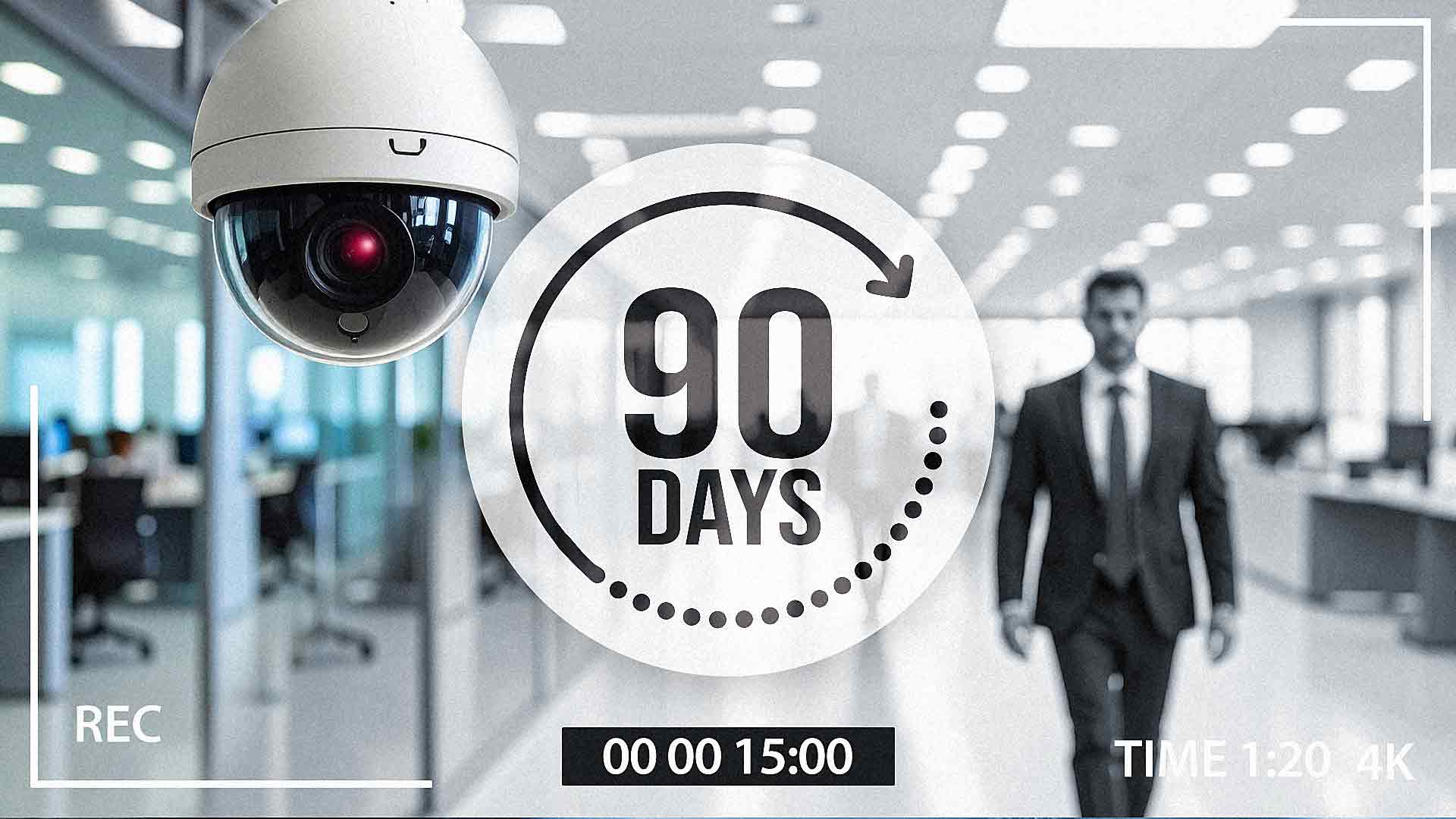How Long Should Your Business Store Security Footage?
June 26th, 2025 | 6 min. read

If you’re investing in a business security camera system, it’s not just about what you see today; it’s about what you might need to see tomorrow.
Whether you’re investigating a break-in, resolving a customer dispute, or complying with legal requirements, having the right video retention policy in place is crucial. But how long should your business store security footage?
The answer isn’t one-size-fits-all. It depends on your industry, risk tolerance, regulatory requirements, and the amount of storage you’re willing to manage.
In this article, we’ll walk you through the key considerations so you can make an informed, legally sound, and cost-effective decision.
Why Security Camera Footage Retention Matters
Security cameras aren’t just for watching real-time events. They’re your digital record of the past, and in many cases, they’re your only proof when something goes wrong.
Let’s say you have a slip-and-fall incident. If you’re not storing footage long enough, that evidence could be gone by the time a claim is filed.
The same goes for internal theft, vandalism, or disputes between employees. Without video, it’s your word against theirs.
Even more importantly, certain industries and jurisdictions require footage to be stored for specific timeframes. Failing to comply could leave you exposed to legal action or regulatory penalties.
And yet, many business owners don’t give retention settings a second thought—until it’s too late.
General Guidelines for How Long to Keep Security Footage
So, how long is "long enough"? While there’s no universal rule, here are some common video retention benchmarks:
- Small businesses or retail shops: 7–30 days
- Offices or commercial buildings: 30–90 days
- Warehouses or industrial sites: 60–90 days
- Schools, hospitals, or banks: 90+ days or more, depending on regulations
A 30-day default is common, especially if you’re using motion-activated cameras or cloud storage solutions. But if your business is in a high-risk or highly regulated industry, you may need to retain footage for several months or even years.
Keep in mind that higher resolution footage (like 4K video) will eat up more space than standard definition video, so storage costs can quickly rise if you’re keeping footage for long periods.
Legal and Industry Compliance Considerations
Before determining how long to store surveillance footage, it is essential to understand the applicable laws for your business. Here's a quick breakdown:
Federal and State Regulations
While there’s no single federal law mandating how long businesses must retain security footage, some states, such as California and New York, may have stricter guidelines, particularly regarding data privacy and video surveillance in public-facing businesses.
If you’re located in California, for example, you may be subject to the CCPA (California Consumer Privacy Act), which affects how video is collected, stored, and shared.
Industry-Specific Rules
Certain industries come with their own mandates:
- Healthcare: Facilities governed by HIPAA may need to store footage related to patient access, though HIPAA doesn't mandate video storage durations outright.
- Retail or financial services: You may need to retain footage of transaction areas in case of fraud investigations.
- Government contractors: May fall under CMMC or FISMA requirements for facility monitoring.
Always consult with legal counsel or compliance advisors to ensure your policy meets the requirements. When in doubt, longer retention is usually safer than not enough.
Key Factors That Affect Footage Storage Duration
How long you can (or should) keep a video doesn’t just depend on policy—it also depends on practical limitations. These are the biggest factors that influence how much footage you can retain.
1. Video Resolution and Frame Rate
Higher resolution = more data. A 4K camera recording at 30 frames per second will fill up storage much faster than a 1080p camera recording at 10 frames per second (fps). If you're using high-res cameras in sensitive areas, consider either larger storage volumes or a shorter retention period for less critical zones.
2. Number of Cameras
The more cameras you have running simultaneously, the more storage you’ll need. A small office with 4–6 cameras can operate efficiently with less space than a multi-building campus with dozens of endpoints.
3. Recording Type: Continuous vs. Motion Detection
Motion-activated recording saves a substantial amount of storage space. If your business doesn’t require 24/7 recording, switching to motion-only capture can help you extend retention without increasing cost.
4. Storage Method: Local vs. Cloud
- Local storage (on-premise NVRs or DVRs) gives you more control and potentially lower costs, but it's limited by hardware capacity.
- Cloud storage is scalable, secure, and often includes built-in retention settings; however, it may require monthly fees based on duration and resolution.
A hybrid system is also possible; store a few days of footage locally for quick access and archive longer-term footage in the cloud.
Tips for Managing and Archiving Security Video
If you plan to retain footage for longer than 30–90 days, it’s not just about having the space; it’s about having a system in place.
Store Archived Footage Securely
If you’re keeping video past its initial retention period for legal or training purposes, ensure it’s encrypted, backed up, and access-controlled. Footage that’s easily copied or shared can open you up to privacy concerns.
Organize and Tag Footage
Footage related to an incident should be appropriately labeled and timestamped. Some surveillance systems allow tagging or bookmarking key moments. This makes it easier to retrieve what you need when you need it.
Purge Footage When It's No Longer Needed
Old footage should be deleted securely to protect employee and customer privacy. Most systems allow you to schedule auto-deletion based on retention policies.
How a Security Provider Can Help You Choose the Right Retention Policy
If all this sounds complicated, don’t worry—that’s where an expert security solutions provider like AIS comes in.
We help businesses:
- Evaluate legal and operational risks
- Align storage duration with business needs
- Choose between on-site, cloud, or hybrid storage
- Configure retention settings within your camera system
- Scale storage as your business grows
There’s no point in recording everything if you can’t find what you need when it matters—or if you accidentally overwrite key evidence.
Final Thoughts: Storing Your Business Security Footage
So, how long should your business store security footage? There’s no one right answer—but there is a right answer for your business.
Most companies store footage for 30 to 90 days, but that number should be based on your legal obligations, operational risks, and how your surveillance system is configured. The key is to be intentional about it.
Document your policy. Align it with industry standards. Also, ensure that your storage can handle it.
If you’re unsure whether your current setup meets your needs—or if you haven’t reviewed your retention settings in a while—AIS can help. We specialize in building video surveillance systems that are secure, compliant, and built to last.
A true southerner from Atlanta, Georgia, Marissa has always had a strong passion for writing and storytelling. She moved out west in 2018 where she became an expert on all things business technology-related as the Content Producer at AIS. Coupled with her knowledge of SEO best practices, she's been integral in catapulting AIS to the digital forefront of the industry. In her free time, she enjoys sipping wine and hanging out with her rescue-dog, WIllow. Basically, she loves wine and dogs, but not whiny dogs.



